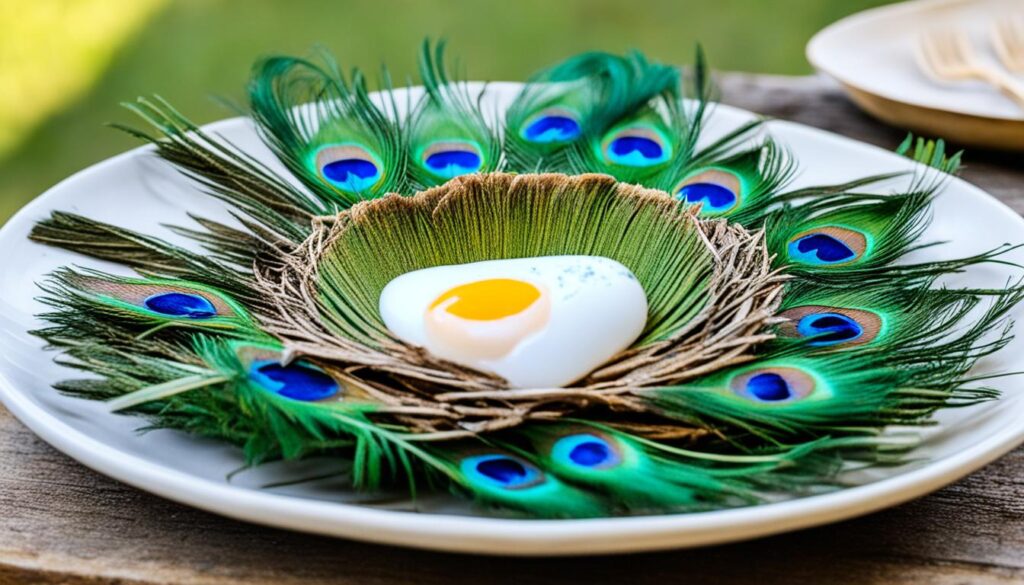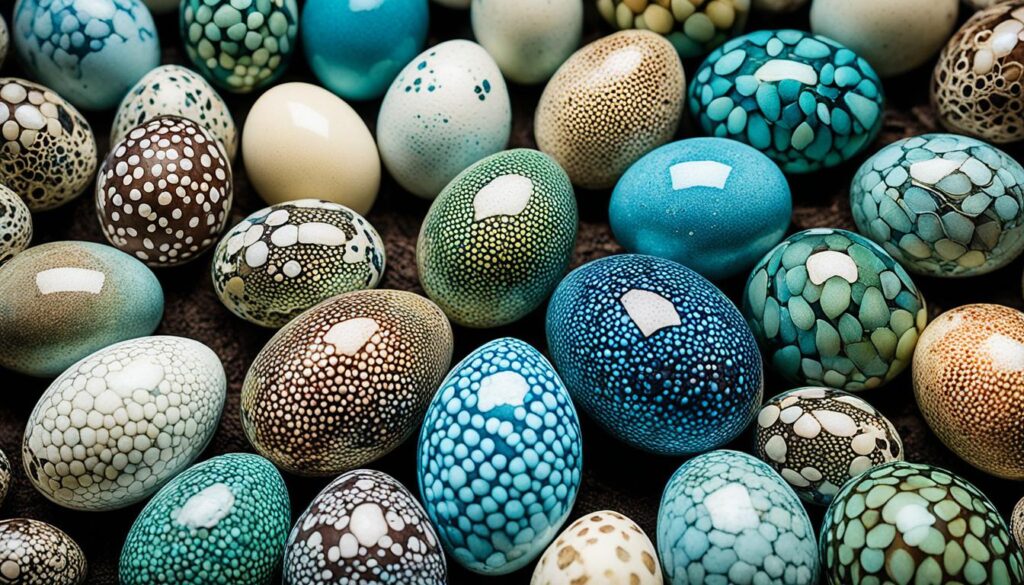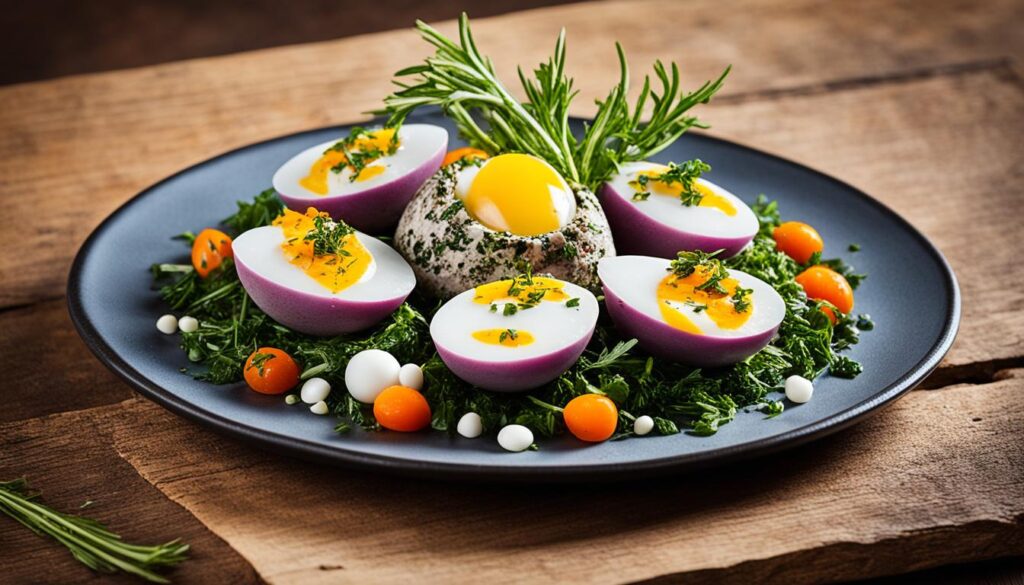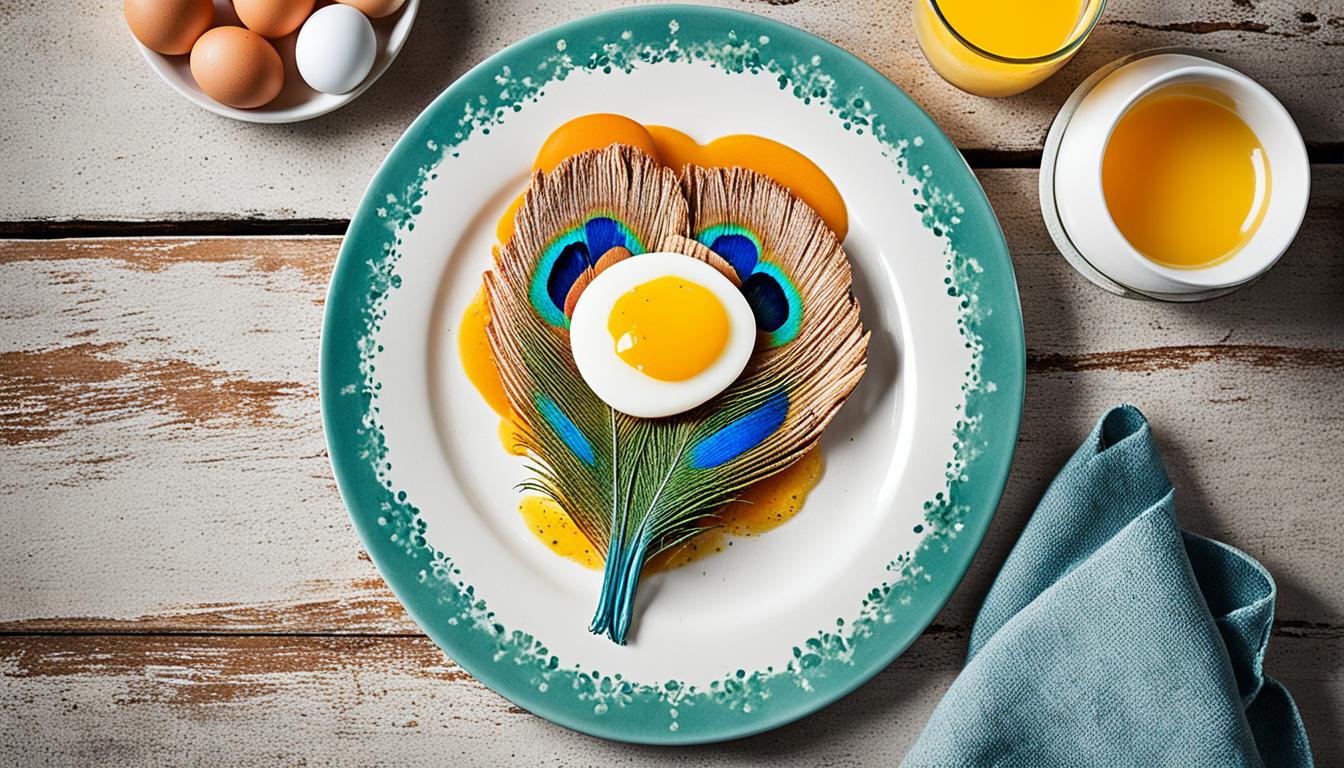Did you realize that peacock eggs are approximately 50% larger than chicken eggs? This interesting fact raises the question – are peacock eggs edible? Let’s explore the culinary realm of peafowl eggs and uncover their flavor, suitability for consumption, and the reasons why they are not typically eaten.
Key Takeaways:
- Peacock eggs are safe to eat and have a similar taste to chicken eggs, but with a richer, more intense flavor.
- Peafowl eggs are not commonly consumed due to their rarity and limited availability.
- The scarcity of peacock eggs and their different taste profile contribute to their lack of popularity in culinary culture.
- Peacock eggs have a distinct color and appearance, with a light brown or pale brown hue.
- Peacock eggs can be incubated artificially or naturally, with an incubation period of around 28 to 30 days.
The Size and Reproduction of Peacock Eggs
Peacock eggs, renowned for their impressive size and unique reproductive process, offer fascinating insights into the world of avian reproduction and culinary possibilities. These vibrant and ornate birds, known for their elegant plumage, produce eggs that are larger than those of chickens, measuring approximately 3 inches in length and 2 inches in width.
The size of peacock eggs can vary depending on the breed and overall health of the peafowl. These magnificent eggs are laid exclusively by female peahens, with each hen typically laying one egg per day for about eight consecutive days during the spring season.
The daily production of peahen eggs provides a fascinating glimpse into the reproductive capabilities of these remarkable birds. However, the development of these eggs into new life requires the vital role of a male peacock. The fertilization process is crucial, as only fertilized eggs have the potential to hatch into adorable baby peafowls.
To summarize, the size of peacock eggs and the intricate reproductive process create captivating characteristics that set them apart from other bird eggs. The ever-growing popularity of these unique eggs sparks curiosity and opens up a world of culinary exploration.
The Edibility of Peacock Eggs
Peahen eggs are safe to eat and have been enjoyed by people in the past. While peacock eggs are edible and can be used in cooking, they are not commonly consumed due to their rarity and limited availability. The taste of peacock eggs is similar to that of chicken eggs, but some individuals find them to have a richer, more intense flavor. The flavor of the eggs may vary depending on the diet of the peafowl and whether they are wild or raised by humans.
For those curious about the culinary possibilities of peacock eggs, they can be prepared and used in recipes just like regular eggs. Whether it’s scrambled, fried, boiled, or incorporated into baked goods, peacock eggs can add a unique twist to traditional dishes. However, it’s important to note that sourcing peacock eggs can be quite challenging due to their scarcity, making them a rare delicacy to come across.
| Can You Eat Peacock Eggs? | Taste of Peacock Eggs |
|---|---|
| Peahen eggs are safe to eat and can be used in cooking. | Peacock eggs taste similar to chicken eggs but with a richer, more intense flavor. |
| Peacock eggs are not commonly consumed due to their rarity and limited availability. | The taste of peacock eggs may vary depending on the diet and lifestyle of the peafowl. |
| They can be prepared and used in recipes like regular eggs. | Sourcing peacock eggs can be challenging due to their scarcity. |
It’s worth noting that consuming peacock eggs should be done responsibly and in accordance with local regulations. Additionally, it’s important to ensure that any eggs used for consumption are fresh and properly handled to prevent any potential foodborne illnesses.
Peacock Eggs vs. Chicken Eggs: A Taste Comparison
“Peacock eggs have a richer, more intense flavor compared to chicken eggs. The taste is often described as creamier and with a subtle earthy undertone. This unique taste can add depth and complexity to dishes, making them a favorite among adventurous eaters.” – Chef Emily Thompson, The Culinary Explorer
According to Chef Emily Thompson, a renowned culinary expert, peacock eggs offer a delightful culinary experience with their distinct taste. While chicken eggs are a popular choice in most kitchens, peacock eggs can bring a touch of novelty and flavor to any meal.

Why Peacock Eggs Aren’t Popular
The main reason why peacock eggs are not commonly eaten is their scarcity. Compared to chickens, peacocks do not lay eggs as frequently, making their eggs rarer and harder to find. Additionally, the more intense taste of peacock eggs may not appeal to everyone’s palate, making them a less popular choice. The limited availability and different taste profile contribute to the eggs’ lack of popularity in culinary culture.

Peacock eggs are not widely consumed due to their scarcity in comparison to chicken eggs. Peafowl, unlike chickens, do not lay eggs as frequently, making them harder to find in the market. The rarity of peacock eggs makes them a delicacy for those lucky enough to come across them. Moreover, the taste of peacock eggs is distinct and may not be preferred by everyone. The intensity of flavor may be offputting to some individuals, further contributing to the lack of demand for peacock eggs in culinary circles.
| Reasons |
Explanation |
|---|---|
| Scarcity | Peacocks lay eggs less frequently than chickens, making their eggs rarer and harder to find in the market. |
| Taste Profile | The intense flavor of peacock eggs may not suit everyone’s palate, leading to them being a less popular choice among consumers. |
In summary, the scarcity and different taste profile of peacock eggs are the primary reasons why they are not commonly eaten. While they offer a unique culinary experience, peacock eggs remain a rare and uncommon ingredient in most kitchens.
The Color and Appearance of Peacock Eggs
Peacock eggs are visually stunning, with distinct colors and unique characteristics that set them apart from chicken eggs. Unlike the typical white or brown hue of chicken eggs, peahen eggs showcase a light brown or pale brown coloration, often adorned with darker spots. These captivating markings result from the addition of pigments during the egg formation process, lending peacock eggs their remarkable appearance.
However, it’s not just the color that distinguishes peacock eggs. Their elongated shape sets them apart from the traditional oval shape of chicken eggs. This elongation adds to the overall elegance and allure of these exquisite eggs, making them a fascinating subject for observation and admiration.
To fully appreciate the beauty of peacock eggs, take a look at the image below:

The Incubation and Hatching of Peacock Eggs
Peacock eggs are a fascinating subject when it comes to the process of incubation and hatching. These beautiful and unique eggs can be incubated either artificially in an incubator or naturally by a broody peahen. The incubation period for peacock eggs is around 28 to 30 days, during which the eggs require optimal conditions such as temperature and humidity to ensure successful hatching.

Hatching peacock eggs is an exciting and rewarding experience. Once the eggs hatch, peachicks, or baby peafowls, enter the world and require proper care and nourishment to thrive. Peahens, the female peacocks, usually start laying eggs at around 2 years old and can lay eggs for about six to eight days. This period marks the beginning of new life and the continuation of the peafowl population.
Collecting Pigeon Eggs
Pigeons, known for their adaptability, tend to lay their eggs in unconventional locations such as building ledges, tree branches, and window sills. Locating pigeon nests can be an exciting and adventurous task, whether you’re navigating the urban landscape or exploring rural areas where pigeons thrive.
When collecting pigeon eggs, it’s essential to exercise caution and respect for these delicate treasures. Pigeon eggs can be fragile, so handling them carefully is crucial to ensure their viability. It’s also important to note that disturbing pigeon nests may disrupt the birds’ breeding patterns and impact their populations.
The availability of pigeon eggs follows a seasonal pattern. The reproductive cycle of pigeons is influenced by the lengthening of daylight hours, with peak egg-laying activity typically occurring during the spring and summer months.
To give you a glimpse into the locations where pigeon nests can be found, here are a few examples:
| Type of Location | Description |
|---|---|
| Building Ledges | Pigeons often build their nests on ledges of tall buildings, finding shelter in the concrete nooks and crannies. |
| Tree Branches | Pigeon nests can be nestled among the branches of trees, providing a secure and elevated spot for their eggs. |
| Window Sills | Window sills are another favored nesting location for pigeons, offering protection and easy access to urban areas. |
Remember, while it can be fascinating to collect pigeon eggs, it’s important to do so responsibly, respecting the birds and their habitats. Observing the nests from a distance and capturing the beauty through photography is a wonderful way to appreciate these remarkable creatures.

Nutritional Value and Culinary Uses of Pigeon Eggs
Pigeon eggs are not only a delicious culinary treat but also offer a range of nutritional benefits. These petite eggs are nutritionally similar to chicken eggs, providing high-quality protein, essential vitamins, and minerals.
Pigeon eggs are an excellent source of high-quality protein, which is essential for muscle building and repair. They are also rich in essential vitamins such as B12 and D, which play a crucial role in maintaining healthy bones, supporting the immune system, and promoting overall well-being. Additionally, pigeon eggs contain minerals like iron, which is important for oxygen transport in the body, and selenium, which acts as a powerful antioxidant.
Beyond their nutritional value, pigeon eggs also offer a unique flavor profile that sets them apart from other types of eggs. These eggs have a delicate yet distinct taste with hints of sweetness and earthiness. This unique flavor adds depth and complexity to various culinary creations.
In Asian cuisine, pigeon eggs are highly regarded for their culinary uses. They are commonly used in soups, where their flavor subtly enhances the overall taste. Pigeon eggs are also boiled or steamed alongside vegetables, creating a wholesome and flavorful dish. Additionally, these eggs can be pickled for a tangy twist or used in various egg dishes, such as omelets or scrambled eggs, to add a touch of uniqueness.
“Pigeon eggs bring a distinct flavor and texture to dishes, making them a prized ingredient in many culinary traditions,” says Chef Karen Lee, a renowned expert in Asian cuisine.
The following table provides a breakdown of the nutritional value of pigeon eggs compared to chicken eggs:
| Nutrient | Pigeon Eggs | Chicken Eggs |
|---|---|---|
| Protein (g) | 6.3 | 6.3 |
| Fat (g) | 4.1 | 5.3 |
| Cholesterol (mg) | 195 | 186 |
| Vitamin B12 (mcg) | 2.1 | 0.6 |
| Vitamin D (IU) | 212 | 82 |
| Iron (mg) | 1.3 | 0.9 |
| Selenium (mcg) | 14.5 | 15.4 |
As seen in the table, pigeon eggs and chicken eggs have similar protein content, but pigeon eggs contain slightly higher amounts of fat, cholesterol, vitamin B12, vitamin D, iron, and selenium. These differences in nutritional composition contribute to the unique characteristics and culinary uses of pigeon eggs.
With their nutritional value and distinct flavor, pigeon eggs are considered a luxury ingredient and a delight for adventurous food enthusiasts seeking a unique gastronomic experience.

Conclusion
Peacock eggs and pigeon eggs present exciting culinary possibilities for those seeking unique flavors and experiences in the kitchen. With their larger size and richer taste compared to chicken eggs, peacock eggs offer a gourmet twist to traditional egg dishes. However, due to their scarcity, peacock eggs are not commonly consumed in culinary culture.
On the other hand, pigeon eggs contribute their distinct flavor profile and are widely used in various Asian cuisines. These eggs provide essential nutrients, including high-quality protein, vitamins, and minerals, making them a nutritious choice for culinary enthusiasts.
Whether using peacock eggs or pigeon eggs, adventurous cooks can explore a range of culinary delights. Incorporating these eggs into diverse dishes has the potential to elevate flavors and create unforgettable culinary experiences. Whether it’s exploring the rich and intense taste of peacock eggs or enjoying the unique sweetness and earthiness of pigeon eggs, these eggs can offer exciting possibilities in the kitchen.










